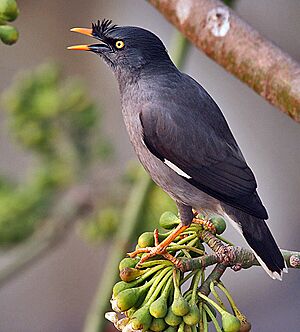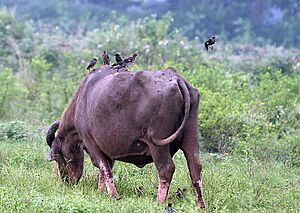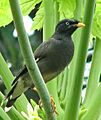Jungle myna facts for kids
Quick facts for kids Jungle myna |
|
|---|---|
 |
|
| A. f. fuscus | |
| Conservation status | |
| Scientific classification | |
| Genus: |
Acridotheres
|
| Species: |
fuscus
|
| Subspecies | |
|
|
| Synonyms | |
|
|
The jungle myna (Acridotheres fuscus) is a type of myna bird. It belongs to the starling family. You can find it in many parts of the Indian Subcontinent. However, it does not live in the very dry areas of India.
It is easy to spot the jungle myna. It has a special tuft of feathers on its forehead. This tuft forms a crest, like a small crown. Other similar birds, like the Javan myna, also have this crest. The jungle myna's eyes can be pale yellow or blue. This depends on where the bird lives. Its bill is orange-yellow, but the bottom part is dark.
People have brought jungle mynas to many other places. These include Fiji, Taiwan, and parts of Japan. Sometimes this was on purpose, and sometimes by accident. The birds have also flown to some Pacific islands on their own.
Contents
What Does the Jungle Myna Look Like?
Jungle mynas are about 23 centimeters (9 inches) long. They have grey feathers. Their head and wings are a darker grey. Male and female jungle mynas look the same.
When they fly, you can see large white patches on their wings. Their tail feathers also have wide white tips. The tuft of feathers on their forehead starts at the base of their bill. Their bill and legs are bright yellow. Unlike some other mynas, they do not have bare skin around their eyes. Adult birds have a dark base to their beak. The lower part of the beak might have a blue shade.
Mynas in southern India have blue eyes. Those in northeastern India have a smoky dark belly. Young jungle mynas are browner. Their throat and the middle of their belly are pale. Sometimes, a jungle myna can have unusual pale feathers. This is called leucism.
The jungle myna's calls sound higher than those of the common myna. When they are in a group, they make short, chirping sounds to keep in touch.
Where Do Jungle Mynas Live?
The jungle myna is a common bird in tropical southern Asia. You can find it in countries like Nepal, Bangladesh, and India. The specific type called fuscus lives across northern India. It ranges from Mount Abu to Puri in Orissa.
People introduced these birds to the Andaman Islands and Fiji. This happened around 1890. They hoped the mynas would help control insect pests in sugarcane fields. Jungle mynas have also spread to some Pacific Islands, like Niuafo'ou. Here, they can be a problem for local birds. They compete for nesting spots, especially with lories.
In many parts of Asia, people keep jungle mynas as pets. Some of these birds have escaped and now live freely in places like Taiwan. They have also started breeding in Japan and Western Samoa. In Malaysia, a type of jungle myna called torquatus is becoming rarer. They might be losing out to Javan mynas, and sometimes they even breed together.
These common birds usually live in forests and farmlands. They often stay close to water. After the breeding season, they might move to new areas.
What Do Jungle Mynas Eat?

Jungle mynas eat many different things. They are omnivores. Their diet includes insects, fruits, and seeds. They mostly look for food on the ground. Often, they feed alongside other myna species.
They also eat berries from small bushes like Lantana. They drink nectar from large tree flowers, such as those of Erythrina trees. Their forehead tuft can even help pollinate these flowers. They also drink water collected in the flowers of trees like Spathodea campanulata.
Jungle mynas sometimes perch on large grazing animals, like buffalo. They pick off tiny bugs from the animals' bodies. They also catch insects that fly up from the plants when the animals move. Groups of mynas might follow farmers who are ploughing fields. They also eat food waste in towns and cities. Sometimes, they even catch larger prey, like small mice, to feed their young. In Fiji, they have been seen using a millipede to rub on their feathers. This is a behavior called anting.
Reproduction and Life Cycle
The jungle myna's breeding season is in summer, before the rainy season. In southern India, it's from February to May. In northern India, it's from April to July.
These birds nest in holes. They use holes in trees or in human-made structures. This includes walls, banks, and houses. Their nests are usually 2 to 6 meters (6 to 20 feet) above the ground. Since they use existing holes, they compete with other birds that also nest in holes. In Malaysia, they have been seen nesting in the leaf bases of palm trees.
Sometimes, they use shed snake skins to line the inside of their nest. In the Himalayan mountains, they use dry pine needles. A female jungle myna usually lays 4 to 6 eggs. The eggs are a beautiful turquoise blue color. Both the male and female birds help build the nest. They also take turns sitting on the eggs and feeding the young birds.
Jungle mynas often gather in large groups to sleep. They might roost with other mynas in sugarcane fields or reedy areas.
Images for kids




